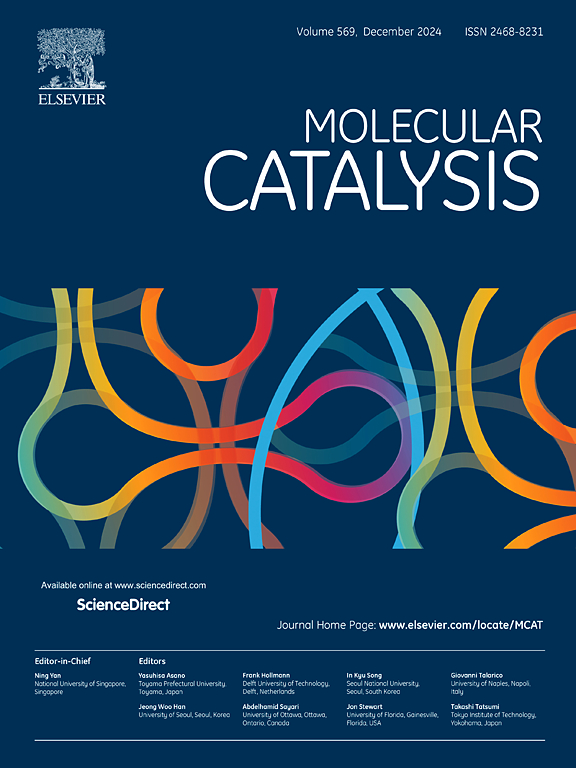基于DFT的直接Z-scheme SnS₂/WTe₂异质结增强可见光驱动水分解性能
IF 3.9
2区 化学
Q2 CHEMISTRY, PHYSICAL
引用次数: 0
摘要
化石燃料的使用导致了诸如全球变暖和酸雨等环境问题。光催化制氢已成为解决这一问题的趋势。然而,单组分光催化剂中光生电子和空穴的快速复合严重限制了其光催化性能。范德华异质结能有效抑制载流子复合速率。因此,本研究通过垂直堆叠方法构建了SnS₂/WTe₂范德华异质结,并利用第一性原理计算研究了它们的稳定性、电子结构、光学性质和光催化机制。结果表明,SnS₂/WTe₂异质结结构稳定,价带最大值(VBM)和导带最小值(CBM)分别由WTe₂和SnS₂主导。这种异质结的氧化和还原电位跨越水的氧化还原电位,使光催化水分解正常进行。与单层材料相比,SnS2/WTe2异质结具有优越的光吸收性能和折射率。在AM1.5G太阳通量下,产氢效率达到9.39%。双轴应变的应用进一步优化了SnS₂/WTe₂异质结的电子和光学性能。基于吉布斯自由能计算,SnS₂/WTe₂异质结表现出高效的HER和OER性能。该研究为开发高效析氢反应催化剂提供了极具前景的候选材料。本文章由计算机程序翻译,如有差异,请以英文原文为准。

Direct Z-scheme SnS₂/WTe₂ heterojunction for enhanced visible-light-driven water splitting performance based on DFT
The use of fossil fuels leads to environmental issues such as global warming and acid rain. Photocatalytic hydrogen production has become a trend towards solving this problem. However, the rapid recombination of photo-generated electrons and holes in single-component photocatalysts severely limits their photocatalytic performance. Van der Waals (vdW) heterojunctions can effectively suppress the carrier recombination rate. Therefore, this study constructs SnS₂/WTe₂ van der Waals heterojunctions via a vertical stacking approach and employs first-principles calculations to investigate their stability, electronic structure, optical properties, and photocatalytic mechanisms. The results demonstrate that the SnS₂/WTe₂ heterojunction exhibits structural stability, with the valence band maximum (VBM) and conduction band minimum (CBM) dominated by WTe₂ and SnS₂, respectively. The oxidation and reduction potentials of this heterojunction span the redox potential of water, enabling photocatalytic water splitting to proceed normally. Compared to the single-layer materials, the SnS2/WTe2 heterojunction exhibits superior light absorption properties and refractive index. Furthermore, it achieves a hydrogen production efficiency of 9.39 % under AM1.5G solar flux. The application of biaxial strain further optimizes the electronic and optical properties of the SnS₂/WTe₂ heterojunction. The SnS₂/WTe₂ heterojunction exhibits efficient HER and OER performance based on Gibbs free energy calculations. This study provides a highly promising candidate material for the development of high-efficiency hydrogen evolution reaction catalysts.
求助全文
通过发布文献求助,成功后即可免费获取论文全文。
去求助
来源期刊

Molecular Catalysis
Chemical Engineering-Process Chemistry and Technology
CiteScore
6.90
自引率
10.90%
发文量
700
审稿时长
40 days
期刊介绍:
Molecular Catalysis publishes full papers that are original, rigorous, and scholarly contributions examining the molecular and atomic aspects of catalytic activation and reaction mechanisms. The fields covered are:
Heterogeneous catalysis including immobilized molecular catalysts
Homogeneous catalysis including organocatalysis, organometallic catalysis and biocatalysis
Photo- and electrochemistry
Theoretical aspects of catalysis analyzed by computational methods
 求助内容:
求助内容: 应助结果提醒方式:
应助结果提醒方式:


